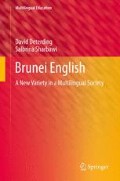Abstract
This chapter considers word structure, particularly the presence and absence of suffixes to indicate number and tense, and then discusses other aspects of syntax, including modal verbs such as ‘will’ and ‘would’, the occurrence of the auxiliary verb ‘do’, finite clauses with no subject, the use of determiners such as ‘a’ and ‘the’ before count and non-count nouns, subject-auxiliary inversion in indirect questions, and the use of prepositions between verbs and their objects, such as ‘discuss about’. Attempts are made to quantify the use of the -s suffix on nouns and on verbs and also the occurrence of articles in the spoken data, though other aspects of the syntax of Brunei English are more tentative, relying on a few examples to illustrate various salient features that characterise the structure of sentences. It is finally suggested that many of the patterns found in Brunei English represent regularisation of English and furthermore they are shared by other new varieties of English, so some of the innovative patterns in Brunei may reflect the ways that English is evolving worldwide.
Access this chapter
Tax calculation will be finalised at checkout
Purchases are for personal use only
References
Alsagoff, Lubna, and Chee Lick Ho. 1998. The grammar of Singapore English. In English in new cultural contexts: Reflections from Singapore, ed. Joe Foley et al., 127–151. Singapore: Singapore Institute of Management/Oxford University Press.
Bao, Zhimin. 1995. Already in Singapore English. World Englishes 14: 181–188.
Baskaran, Loga. 2004b. Malaysian English: Morphology and syntax. In A handbook of varieties of English. Volume 2: Morphology and syntax, ed. Bernd Kortmann, Kate Burridge, Rajend Mesthrie, Edgar W. Schneider, and Clive Upton, 1073–1085. Berlin: Mouton de Gruyter.
Cane, Graeme. 1994. The English language in Brunei Darussalam. World Englishes 13: 351–360.
Carter, Ronald, and Michael McCarthy. 2006. Cambridge grammar of English: A comprehensive guide. Cambridge: Cambridge University Press.
COCA. 2012. The Corpus of Contemporary American English. corpus.byu.edu/coca/. Accessed 29 April 2012.
Cogo, Alessia, and Martin Dewey. 2012. Analysing English as a lingua franca: A corpus-driven investigation. London: Continuum.
Collins, Peter. 2012. Singular agreement in there existentials. English World-Wide 33: 51–68.
Cruttenden, Alan. 2008. Gimson’s pronunciation of English, 7th ed. London: Hodder Education.
Deterding, David. 2000. Potential influences of Chinese on the written English of Singapore. In English in Southeast Asia 99, ed. Adam Brown, 201–209. Singapore: National Institute of Education.
Deterding, David. 2003. Tenses and will/would in a corpus of Singapore English. In English in Singapore: Research on grammar, ed. David Deterding, Low Ee Ling, and Adam Brown, 31–38. Singapore: McGraw-Hill.
Deterding, David. 2007a. Singapore English. Edinburgh: Edinburgh University Press.
Deterding, David. 2012. Issues in the acoustic measurement of rhythm. In Pragmatics and prosody in English language teaching, ed. Jesús Romero-Trillo, 9–24. Dordrecht: Springer.
Greenbaum, Sydney, and Randolph Quirk. 1990. A student’s grammar of the English language. Harlow: Longman.
Ho, Debbie G.E. 2009. Exponents of politeness in Brunei English. World Englishes 28: 35–51.
Lim, Gerard. 2001. Till death do us part: The case of Singaporean and Malaysian English. In Evolving identities: The English language in Singapore and Malaysia, ed. Vincent Ooi, 125–139. Singapore: Times Academic Press.
Mesthrie, Rajend, and Rakesh M. Bhatt. 2008. World Englishes: The study of linguistic varieties. Cambridge: Cambridge University Press.
Nelson, Gerald, Sean Wallis, and Bas Aarts. 2002. Exploring natural language: Working with the British component of the International Corpus of English. Amsterdam/Philadelphia: John Benjamins.
O’Hara-Davies, Breda. 2010. Brunei English: A developing variety. World Englishes 29: 406–419.
Setter, Jane, Cathy S.P. Wong, and Brian H.S. Chan. 2010. Hong Kong English. Edinburgh: Edinburgh University Press.
Tan, Ludwig. 2003. Topic prominence and null arguments in Singapore colloquial English. In English in Singapore: Research on grammar, ed. David Deterding, Low Ee Ling, and Adam Brown, 1–10. Singapore: McGraw-Hill.
Author information
Authors and Affiliations
Rights and permissions
Copyright information
© 2013 Springer Science+Business Media Dordrecht.
About this chapter
Cite this chapter
Deterding, D., Sharbawi, S. (2013). Morphology and Syntax. In: Brunei English. Multilingual Education, vol 4. Springer, Dordrecht. https://doi.org/10.1007/978-94-007-6347-0_4
Download citation
DOI: https://doi.org/10.1007/978-94-007-6347-0_4
Published:
Publisher Name: Springer, Dordrecht
Print ISBN: 978-94-007-6346-3
Online ISBN: 978-94-007-6347-0
eBook Packages: Humanities, Social Sciences and LawEducation (R0)

